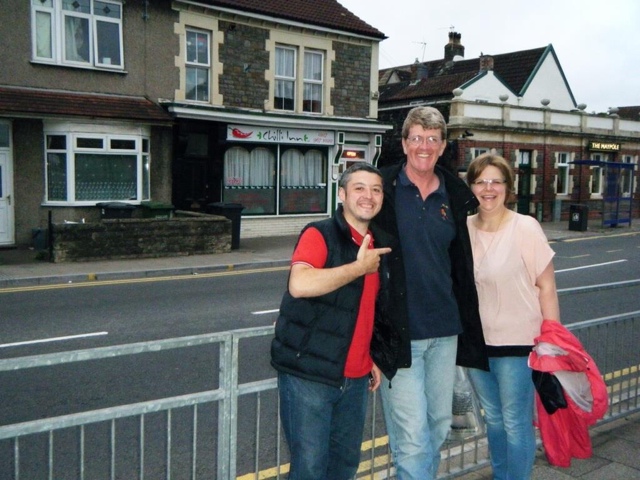From Berlin we took a direct train to Bielefeld, the site of a British military installation, to visit Nigel and Moira, parents of Libby, our son's partner. This was our second time scrounging off them. I think they are getting to know us. The four of us had planned a quick visit to Barcelona so after three days of visiting Bielefeld (including a trip to the Thermalbad - textilefrei saunas, German style) we hopped a Germanwings budget flight to Barna (slang for Barcelona). Here's a plug for Germanwings - best legroom ever!
We arrived in Barna at two-ish, during the hottest part of the day. The humidity was 100% and the sun was blazing. The walk from the airport to the train, through a glass enclosed elevated walkway, made me feel like a dog in a car on a hot Ottawa day. That was just the beginning. The most difficult part of the move from Bielefeld to Barna was the ground move from the airport to the flat. After the trek through the glass over pass, we fought our way onto a commuter train into the city. It was also quite crowded, but air-conditioned.
It was wonderful. We had to change trains in the middle of Barna to get on a southbound tube. The walk from one to the other was incredibly long. The tunnel we were walking in was barely high enough for me to stand up straight. There were hundreds of hot tired tourists plodding along in the 100% humidity and foetid air of the passageway. After what seemed like an eternity we got to the end and burrowed even further down looking for our train. We were tropical moles.
When we got to our stop we emerged into the street only to find that the skies had clouded over, the wind had picked up and rain was on the way. We walked to the Barri Gotic, where we were staying, and found a small cafe to wait for our host. While we sat there, everyone else went into panic mode, grabbed all their stuff and ducked underneath anything they could find. How bad could it get, we thought. What's all the fuss. Seconds later it was tropical moles in a mediterranean rain squall.
Welcome to Barcelona!
A few minutes later our hostess arrived (by bicycle) and let us into the flat. It was terrific. Two bedrooms, two bathrooms, nice kitchen, fully equiped with everything from dishwasher to dryer. And, best of all, it was air-conditioned!
Things were looking up! We signed the papers, stashed our kit and headed out for tapas and sangria. The rain had stopped, the streets were clean and full of people, and we were in Barcelona.
Our goal in Barna was to spend a day visiting the touristy stuff (Sagrada Familia, the beach, the Barri Gotic and the Rambla), then spend the rest of the time exploring. We did that. The Sagrada Familia had a zillion people there doing the same thing.

The building is the most exotic and ugly homage to religion ever. I couldn't help but wonder if Gaudi was making fun of the church. Christ with a block head?
From there we walked the 4 or 5 kilometers up to Parc Guell. We hoped that we would beat the crowds, but that was not to be. The lines were huge. The price was ridiculous and the sun was blazing. We had a quick stroll into the free part, snapped a couple pics and bailed. I'll have to Google Parc Guell.
The lines to buy tickets.
From there we walked back down the hill towards the city center. We passed many more people heading up. I wonder if they all went in?
We went to the beach.
The beach is interesting. Apparently Barcelona in particular, and Catalonain general, have made a huge effort in recent years to clean up the beaches and the water and make the place more hospitable. There is even an app for Spanish beach conditions: PlatgesCat. The app will tell you all the stuff you need to know about the beaches. Unfortunately for us it was saying that there was no guarantee of the quality of the water that day. That was good enough for me to stay out, not my darling wife though.
Oh well.
My favourite part of Barcelona is the food and the architecture. No matter where you are, when you look up there is something interesting to see.

When you get tired of looking up, look around. There is a place to eat in every second doorway. Once you are away from the beach and the Rambla, food is cheap and delicious. Tapas are available everywhere. They are generally small portions of something tasty. The word tapas means tops. They were originally small pieces of bread with something savoury on top used to put on top of your drink to keep the flies out. (And I thought it meant "snacks" or something like that.)

The hams and cured meats (charcouterie) of Catalonia are unparalleled. Some of the hams in the picture are 99€ a pound. The guy told me that the hams take years to cure. They use special black pigs fed on olives and acorns. The best is Jamon Serrano or Jamon Iberico. Fabulous!
Barcelona is a special place. The architecture and the food are unlike anywhere else, but there is probably a better time to visit. I understand that even the Barcelonians leave the city in August because of the heat and the tourists. If we were to go again we would research a better time.




















































